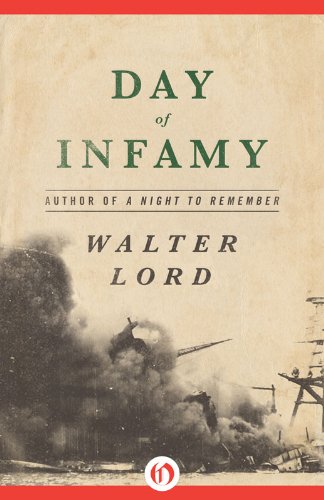Walter Lord, Day of Infamy
Product Details
- File Size: 1133 KB
- Print Length: 237 pages
- Page Numbers Source ISBN: 0805068031
- Publisher: Open Road Media (March 6, 2012)
- Sold by: Amazon Digital Services, Inc.
- Language: English
- ASIN: B0078X73FM
- Text-to-Speech: Enabled
- Lending: Enabled
- Average Customer Review: 4.3 out of 5 stars (91 customer reviews)
- Price: $9.99 (I bought it on sale for $2.51.
 )
)
1. Short review:
For content:
2. Long review:
2.1. What I liked: History as a collection of personal experiences.
Roller-coaster or walk-in-the-park? A roller-coaster.
Great value for the money.
2.2. What I did not like: As with every ebook I have read from Open Road (whom I shall no longer link to), the glut of errors evidences that they OCR-scanned a paper copy and gave the output no proofreading. Some of my corrections: tug vice rug, sealed vice scaled, and see vice sec.
2.3. Who I think is the audience: Everybody.
2.4. Is the book appropriate for children to read? Yes.
2.5. On the basis of reading this book, will I buy the author's next book? I shall buy anything written by Walter Lord. Not so keen on Open Road's products.
2.6. The plot in a nutshell:
No plot. History.2.7. Other:
Besides reading commercially published works about the attack on Pearl Harbor and US Navy and US Army reports, WL interviewed 464 people who were there or with the Japanese attack force. He reconciled their recollections with official reports and records, sometimes favoring recollection over report. (A report is only a recollection reduced to writing. With an official stamp on it.) In effect, Day of Infamy is an oral history reduced to writing.
Because it is effectively an oral history, it has a close, personal feeling other histories lack. The people in the book became my friends, and I wanted to know what happened to them.
I learned a lot from Day of Infamy.
First, I learned that the Japanese attack force included six carriers. That was likely the largest concentration of carriers anywhere up to that time.
Second, the Japanese attack did not go as planned. They had two attack plans: if 'Surprise', the torpedo bombers were to attack first followed by the dive bombers; if 'Surprise Lost', the dive bombers were to attack with the torpedo bombers. IJN Commander Misuo Fuchida decided to go with 'Surprise' and fired one shot from his signal pistol (inbound, the Japanese kept radio silence). This single shot was the signal for 'Surprise'. The fighters did not respond. Fuchida thought they had missed the signal. He fired another. Two shots was the signal for 'Surprise Lost'. Now some crews executed the plan for 'Surprise' and others executed the plan for 'Surprise Lost'.
Third, rumor and misinformation in war can kill. A flight of planes from the USS Enterprise flew into Pearl on the afternoon of the 7th. Even with the Navy tower broadcasting that these were friendlies, the gunners opened up on them. About half were killed, including one shot hanging from his 'chute after he bailed out of his flaming plane.
Fourth, the attack was launched in two waves, not one.
Admiral Chuichi Nagumo, commander of the Japanese attack force, did not agree with the plan, but Yamamoto told him to shut up and soldier. Nagumo feared for his carriers. His mission was to destroy the American fleet at Pearl Harbor. Reconnaissance persuaded him the first attack had accomplished his mission. Rather than launch a second attack, he turned back for Japan.
A second attack would have destroyed Pearl Harbor as an operating naval base. The IJN lost a priceless opportunity.
Rumors on Oahu ran that the Japanese had landed on the island. These were false, but I did wonder what would have been the result had the Japanese included invasion forces with their fleet. Except for the B-17s that landed that day, the US Army Air Corps ceased to exist on Oahu. Three PBYs were out on patrol; all other Navy planes at Pearl were destroyed. The air groups of three carriers were all that the Navy could call on.
Had the Japanese landed invasion forces on Oahu, I think they would have taken the island.
I think the reason they did not attempt an invasion was logistics.
The same day, the IJN and the IJA invaded Guam, Wake, the Philippines, Hong Kong, and Malaysia. Those invasions required lots of troops. Troops require everything from ammo to food to socks. And transport for the troops and all those supplies.
The Japanese did not have enough transport to add an invasion of Oahu.
Few Japanese were available for WL to interview. That is because most of those who attacked Pearl Harbor were dead six months later. At the Battle of Midway. WL wrote a book about Midway, too. Incredible Victory. Also a great read.
YMMV.
2.8. Links: Walter Lord
2.9. Buy the book: Day of Infamy

No comments:
Post a Comment